JVC RX-430VBK User Manual

AUDIO/VIDEO CONTROL RECEIVER
AUDIO/VIDEO-RECEIVER MIT STEUEREINHEIT
AMPLI/TUNER DE COMMANDE AUDIO/VIDEO
GEINTEGREERDE AUDIO/VIDEO-VERSTERKER
RECEPTOR DE CONTROL DE AUDIO/VÍDEO
RICEVITORE DI CONTROLLO AUDIO/VIDEO
RX-430VBK
TV |
|
|
/I |
|
|
|
|
|
|
|
|
|
|
/VIDEO |
TV |
|
VCR |
AUDIO |
|
|
|
|
|
|
|
|
|
CH+ |
1 |
|
PRESET |
SEA MODE |
|
|
|
|
|
|
|
|
|
|
2 |
|
3 |
|
|
|
|
|
|
|
|
||
CH– |
TEST |
|
DELAY SURR MODE |
|
|
|
|
|
|
|
|
||
4 |
|
5 |
|
6 |
|
|
|
|
|
|
|
|
|
|
|
|
– REAR |
+ |
|
|
|
|
|
|
|
|
|
CD |
7/P |
|
8 |
|
9 |
|
|
|
|
|
|
|
|
|
|
|
– CENTER |
+ |
|
|
MASTER VOLUME |
|
|
|
|
|
|
TAPE |
CD-DISC |
10 |
+10 |
AUDIO/VIDEO CONTROL RECEIVER |
|
|
|
|
|
|
|||
|
|
|
|
|
RX-430V |
TUNER/BAND |
PRESET SEA |
SOURCE |
SURROUND |
ADJUST |
SETTING |
||
FM/AM |
AUDIO |
|
SEA |
SURROUND |
|
|
|
|
|
|
|
|
|
CONTROL |
ON/OFF |
ON/OFF |
|
|
|
|
|
|
|
|
|||
VCR |
TV |
TV CONTROL |
+ |
|
– |
+ |
|
|
|
|
|
||
|
– VOLUME |
|
|
|
|
|
|
|
|
||||
VIDEO |
|
|
|
ONE TOUCH |
|
|
|
|
|
|
|
|
|
|
|
|
OPERATION |
|
|
|
|
|
|
|
|
||
|
|
|
|
|
|
|
|
MEMORY |
|
|
|
|
|
|
|
|
|
|
|
|
|
|
|
|
|
ONE TOUCH OPERATION |
|
PHONO |
|
|
|
|
|
|
|
|
|
|
|
|
|
|
– VOLUME + |
MUTE |
|
|
|
|
|
|
|
|
|||
|
RM-SR430EU REMOTE CONTROL |
|
|
|
|
|
|
|
|
||||
|
|
|
|
|
STANDBY |
|
|
|
|
|
|
|
|
|
|
|
|
|
POWER |
PHONES |
SPEAKERS |
|
|
|
|
|
|
|
|
|
|
|
|
1 |
2 |
|
|
|
|
|
|
|
|
|
|
|
|
|
|
|
|
ENHANCED COMPULINK CONTROL SYSTEM |
|||
|
|
|
|
|
_ON —OFF |
|
_ON —OFF |
|
|
|
|
|
|
|
|
|
|
|
STANDBY/ON |
|
|
|
|
|
|
|
|
INSTRUCTIONS
BEDIENUNGSANLEITUNG MANUEL D’INSTRUCTIONS
GEBRUIKSAANWIJZING MANUAL DE INSTRUCCIONES
ISTRUZIONI
For Customer Use:
Enter below the Model No. and Serial No. which are located either on the rear, bottom or side of the cabinet. Retain this information for future reference.
Model No.
Serial No.
LET0022-001A
[EF, G]

Warnings, Cautions and Others/Warnung, Achtung und sonstige Hinweise/ Mises en garde, précautions et indications diverses/Waarschuwingen, voorzorgen en andere mededelingen/Avisos, precauciones y otras notas/ Avvertenze e precauzioni da osservare
IMPORTANT for the U.K.
DO NOT cut off the mains plug from this equipment. If the plug fitted is not suitable for the power points in your home or the cable is too short to reach a power point, then obtain an appropriate safety approved extension lead or consult your dealer.
BE SURE to replace the fuse only with an identical approved type, as originally fitted.
If nonetheless the mains plug is cut off ensure to remove the fuse and dispose of the plug immediately, to avoid a possible shock hazard by inadvertent connection to the mains supply.
If this product is not supplied fitted with a mains plug then follow the instructions given below:
IMPORTANT.
DO NOT make any connection to the terminal which is marked with the letter E or by the safety earth symbol or coloured green or green-and-yellow.
The wires in the mains lead on this product are coloured in accordance with the following code:
Blue : Neutral
Brown : Live
As these colours may not correspond with the coloured markings identifying the terminals in your plug proceed as follows:
The wire which is coloured blue must be connected to the terminal which is marked with the letter N or coloured black.
The wire which is coloured brown must be connected to the terminal which is marked with the letter L or coloured red.
IF IN DOUBT - CONSULT A COMPETENT ELECTRICIAN.
Per I’ltalia:
“Si dichiara che il questo prodotto di marca JVC è conforme alle prescrizioni del Decreto Ministeriale n.548 del 28/08/95 pubblicato sulla Gazzetta Ufficiale della Repubblica Italiana n.301 del 28/12/95.”
G-1

CAUTION
To reduce the risk of electrical shocks, fire, etc.:
1.Do not remove screws, covers or cabinet.
2.Do not expose this appliance to rain or moisture.
ACHTUNG
Zur Verhinderung von elektrischen Schlägen, Brandgefahr, usw:
1.Keine Schrauben lösen oder Abdeckungen enternen und nicht das Gehäuse öffnen.
2.Dieses Gerät weder Regen noch Feuchtigkeit aussetzen.
ATTENTION
Afin d’éviter tout risque d’électrocution, d’incendie, etc.:
1.Ne pas enlever les vis ni les panneaux et ne pas ouvrir le coffret de l’appareil.
2.Ne pas exposer l’appareil à la pluie ni à l’humidité.
VOORZICHTIG
Ter vermindering van gevaar voor brand, elektrische schokken, enz.:
1.Verwijder geen schroeven, panelen of de behuizing.
2.Stel dit toestel niet bloot aan regen of vocht.
PRECAUCIÓN
Para reducir riesgos de choques eléctricos, incendio, etc.:
1.No extraiga los tornillos, los cubiertas ni la caja.
2.No exponga este aparato a la lluvia o a la humedad.
ATTENZIONE
Per ridurre il rischio di scosse elettriche, incendi, ecc...
1.Non togliere viti, coperchi o la scatola.
2.Non esporre l’apparecchio alla piogggia e all’umidità.
English
Deutsch
Français
Nederlands
Español
Italiano
G-2

Caution –– POWER switch and STANDBY/ON 

 button!
button!
This apparatus is provided with a  POWER switch to be able to minimize power consumption for safe use. Therefore,
POWER switch to be able to minimize power consumption for safe use. Therefore,
1.When doing initial setting, complete all the connections required, connect the mains plug into the wall outlet, and set the  POWER switch to ON. After these, it will be available to operate STANDBY/ ON
POWER switch to ON. After these, it will be available to operate STANDBY/ ON 

 button and so on.
button and so on.
2.When not in use, set the  POWER switch to OFF.
POWER switch to OFF.
3.Disconnect the mains plug to shut the power off completely. The
 POWER switch and STANDBY/ON
POWER switch and STANDBY/ON 

 button in any position
button in any position
do not disconnect the mains line.
4. The power can be remote controlled.
Achtung –– POWER-Schalter und STANDBY/ON 

 -Taste!
-Taste!
Dieses Gerät hat einen Netzschalter (  POWER), um den Stromverbrauch für sichere Verwendung auf ein Minimum bringen zu können. Verfahren Sie deshalb wie folgt:
POWER), um den Stromverbrauch für sichere Verwendung auf ein Minimum bringen zu können. Verfahren Sie deshalb wie folgt:
1.Beim ursprünglichen Aufbau alle erforderlichen Anschlüsse herstellen, den Netzstecker in eine Wandsteckdose stecken, und den  POWER-Schalter einschalten. Anschließend ist Betrieb der STANDBY/ON
POWER-Schalter einschalten. Anschließend ist Betrieb der STANDBY/ON 

 -Taste usw. möglich.
-Taste usw. möglich.
2.Wenn das Gerät nicht verwendet wird, den  POWER-Schalter ausschalten.
POWER-Schalter ausschalten.
3.Den Netzstecker aus der Steckdose ziehen, um die
Stromversorgung vollkommen zu unterbrechen. Der  POWERSchalter und die STANDBY/ON
POWERSchalter und die STANDBY/ON 

 -Taste unterbrechen in keiner
-Taste unterbrechen in keiner
Stellung die Stromversorgung vollkommen.
4.Die Stromversorgung kann mit der Fernbedienung einund ausgeschaltet werden.
Attention — Commutateur  POWER et d’une touche STANDBY/ ON
POWER et d’une touche STANDBY/ ON 

 !
!
Cet appareil est équipé d’un commutateur  POWER qui lui permet de réduire sa consommation d’électricité pour une utilisation plus sûre. Par conséquent,
POWER qui lui permet de réduire sa consommation d’électricité pour une utilisation plus sûre. Par conséquent,
1.En procédant au réglage initial, compléter toutes les connexions nécessaires, connecter la fiche secteur dans la prise murale et mettre le commutateur  POWER sur la position ON. Ensuite, il sera possible de contrôler la touche STANDBY/ON
POWER sur la position ON. Ensuite, il sera possible de contrôler la touche STANDBY/ON 

 , etc.
, etc.
2.Mettre le commutateur  POWER sur la position OFF lorsque l’appareil n’est pas utilisé.
POWER sur la position OFF lorsque l’appareil n’est pas utilisé.
3.Déconnecter la fiche secteur pour couper complètement le courant.
Le commutateur  POWER et la touche STANDBY/ON
POWER et la touche STANDBY/ON 

 ne coupent jamais complètement l’alimentation, quelle que soit leurs positions.
ne coupent jamais complètement l’alimentation, quelle que soit leurs positions.
4.L’alimentation peut être télécommandée.
Voorzichtig –– POWER en STANDBY/ON |
schakelaars! |
Dit apparaat is voorzien van een  POWER hoofdschakelaar om het apparaat gebruiksklaar te zetten, maar te zorgen dat het stroomverbruik minimaal blijft. Neem in verband hiermee het volgende in acht:
POWER hoofdschakelaar om het apparaat gebruiksklaar te zetten, maar te zorgen dat het stroomverbruik minimaal blijft. Neem in verband hiermee het volgende in acht:
1.Bij de eerste ingebruikneming zorgt u eerst dat alle aansluitingen
in orde zijn, dan steekt u de stekker in het stopkontakt en dan zet u de  POWER schakelaar in de “ON” stand. Daarna kunt u het apparaat aanen uitschakelen met de STANDBY/ON
POWER schakelaar in de “ON” stand. Daarna kunt u het apparaat aanen uitschakelen met de STANDBY/ON 

 schakelaar.
schakelaar.
2.Wanneer u het apparaat geruime tijd niet gebruikt, kunt u beter de
 POWER schakelaar in de “OFF” stand zetten.
POWER schakelaar in de “OFF” stand zetten.
3.Om de stroomtoevoer geheel uit te schakelen, trekt u de stekker uit het stopkontakt. Anders zal er altijd een geringe hoeveelheid
stroom naar het apparaat lopen, ongeacht de stand van de STANDBY/ON 

 en de
en de  POWER.
POWER.
4.U kunt het apparaat ook met de afstandsbediening aanen uitschakelen.
Precaución –– Interruptor POWER y botón STANDBY/ON 

 !
!
Esta unidad dispone de un interruptor  POWER que sirve para reducir al mínimo el consumo de alimentación para proporcionar mayor seguridad operacional. Por lo tanto,
POWER que sirve para reducir al mínimo el consumo de alimentación para proporcionar mayor seguridad operacional. Por lo tanto,
1.Al ejecutar el ajuste inicial, después de completar todas las
conexiones requeridas, conectar el cable de alimentación a una toma de pared, y activar el interruptor  POWER. Entonces, será posible ejecutar operaciones tales como la conmutación del estado de alimentación.
POWER. Entonces, será posible ejecutar operaciones tales como la conmutación del estado de alimentación.
2.Desactivar el interruptor  POWER al dejar la unidad fuera de uso.
POWER al dejar la unidad fuera de uso.
3.Desconectar el cable de alimentación para desactivar la
alimentación totalmente. Cualquier que sea la posición de ajustes del interruptor  POWER y el botón STANDBY/ON
POWER y el botón STANDBY/ON 

 , la alimentación no es cortada completamente.
, la alimentación no es cortada completamente.
4.La alimentación puede ser controlada remotamente.
Attenzione –– Interruttore POWER e tasto STANDBY/ON 

 !
!
Per ridurre al minimo l’assorbimento di corrente ai fini della sicurezza, questo apparecchio è stato dodato di un interruttore  POWER. Di conseguenza,
POWER. Di conseguenza,
1.Al momento dell’impostazione iniziale, completare tutti i collegamenti richiesti, inserire la spina del cavo di alimentazione
nella presa a muro della rete elettrica e impostare l’interruttore
 POWER in posizione ON. Fatto ciò, sarà pronto all’uso STANDBY/ON
POWER in posizione ON. Fatto ciò, sarà pronto all’uso STANDBY/ON 

 .
.
2.Quando non in uso, impostare l’interruttore  POWER in posizione OFF.
POWER in posizione OFF.
3.Disinserire la spina del cavo di alimentazione dalla presa della rete
elettrica per staccare completamente l’alimentazione. L’ interruttore
 POWER e il tasto STANDBY/ON
POWER e il tasto STANDBY/ON 

 in nessuna posizione staccano la linea di alimentazione elettrica principale.
in nessuna posizione staccano la linea di alimentazione elettrica principale.
4.È possibile il controllo remoto dell’alimentazione.
G-3
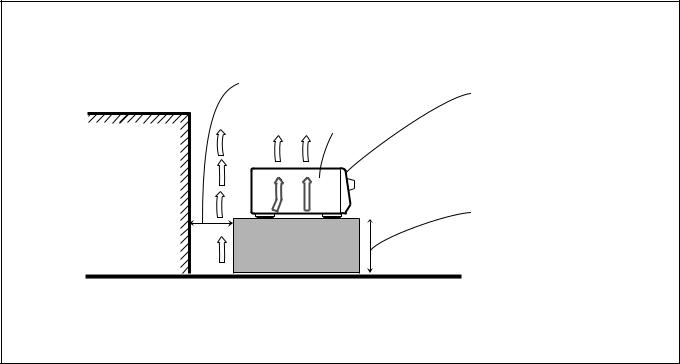
Caution: Proper Ventilation
To avoide risk of electric shock and fire and to protect from damage. Locate the apparatus as follows:
Front: |
No obstructions open spacing. |
Sides: |
No obstructions in 10 cm from the sides. |
Top: |
No obstructions in 10 cm from the top. |
Back: |
No obstructions in 15 cm from the back |
Bottom: |
No obstructions, place on the level surface. |
In addition, maintain the best possible air circulation as illustrated.
Achtung: Angemessene Ventilation
Stellen Sie das Gerät zur Verhütung von elektrischem Schlag und Feuer und zum Schutz gegen Beschädigung wie folgt auf:
Vorderseite: Offener Platz ohne Hindernisse.
Seiten: Keine Hindernisse innerhalb 10 cm von den Seiten.
Oberseite: Keine Hindernisse innerhalb 10 cm von der Oberseite. Rückseite: Keine Hindernisse innerhalb 15 cm von der Rückseite.
Unterseite: Keine Hindernisse. Auf eine ebene Oberfläche stellen. Zusätzlich die bestmögliche Luftzirkulation wie gezeigt erhalten.
Attention: Ventilation Correcte
Pour éviter les chocs électriques, l’incendie et tout autre dégât. Disposer l’appareil en tenant compte des impératifs suivants
Avant: |
Rien ne doit gêner le dégagement |
Flancs: |
Laisser 10 cm de dégagement latéral |
Dessus: |
Laisser 10 cm de dégagement supérieur |
Arrière: |
Laisser 15 cm de dégagement arrière |
Dessous: |
Rien ne doit obstruer par dessous; poser l’appareil sur |
|
une surface plate. |
Veiller également à ce que l’air circule le mieux possible comme illustré.
Voorzichtig: Zorg Voor Goede Ventilatie
Om gevaar voor brand of een elektrische schok te voorkomen, dient u bij opstelling van het apparaat op de volgende punten te letten:
Voorkant: |
Voldoende ruimte vrij houden. |
Zijkanten: |
Minstens 10 cm aan weerszijden vrij houden. |
Bovenkant: |
Niets bovenop plaatsen; 10 cm speling geven. |
Achterkant: Minstens 15 cm ruimte achteraan vrij houden. Onderkant: Opstellen op een egaal horizontaal oppervlak.
Bovendien moet er rondom voldoende luchtdoorstroming zijn, zoals in de afbeelding aangegeven.
Precaución: Ventilación Adecuada
Para evitar el riesgo de choque eléctrico e incendio y para proteger el aparato contra daños.
Ubique el aparato de la siguiente manera:
Frente: |
Espacio abierto sin obstrucciones |
Lados: |
10 cm sin obstrucciones a los lados |
Parte superior: |
10 cm sin obstrucciones en la parte superior |
Parte trasera: |
15 cm sin obstrucciones en la parte trasera |
Fondo: |
Sin obstrucciones, colóquelo sobre una superficie |
|
nivelada |
Además, mantenga la mejor circulación de aire posible como se ilustra.
Attenzione: Problemi di Ventilazione
Per evitare il rischio di folgorazioni ed incendi e proteggere l’unità da danni, installarla nel modo seguente.
Davanti: |
Nessun ostacolo, spazio libero |
Lati: |
Nessun ostacolo per almeno 10 cm |
Sopra: |
Nessun ostacolo per almeno 10 cm |
Retro: |
Nessun ostacolo per almeno 15 cm |
Fondo: |
Libero ed in piano |
Inoltre, mantenere il più possibile la circolazione dell’aria.
Spacing 15 cm or more Abstand von 15 cm oder mehr Dégagement de 15 cm ou plus Minstens 15 cm tussenruimte Espacio de 15 cm o más
15 cm di distanza o più
RX-430VBK
Wall or obstructions
Wand oder Hindernisse
Mur, ou obstruction
Wand of meubilair
Pared u obstrucciones
Parete o ostacol
Floor
Boden
Plancher
Vloer
Piso
Pavimento
Front
Vorderseite
Avant
Voorkant
Frente
Davanti
Stand height 15 cm or more Standhöhe 15 cm oder mehr Hauteur du socle: 15 cm ou plus
Standard op minstens 15 cm van de vloer Allura del soporte 15 cm o más
Altezza del tavolino 15 cm p plù
G-4

English
Table of Contents
Switches, Buttons and Controls ................................................................................................ |
2 |
Getting Started ........................................................................................................................... |
3 |
Before Installation .................................................................................................................... |
3 |
Checking the Supplied Accessories ......................................................................................... |
3 |
Connecting the FM and AM (MW/LW) Antennas .................................................................. |
4 |
Connecting the Speakers .......................................................................................................... |
5 |
Connecting Audio/Video Components .................................................................................... |
7 |
Connecting Audio Components for the COMPU LINK-3 Remote Control System ............... |
8 |
Connecting the Power Cord ..................................................................................................... |
9 |
Putting Batteries in the Remote Control .................................................................................. |
9 |
Basic Operations ...................................................................................................................... |
10 |
Turning the Power On and Off (Standby) .............................................................................. |
10 |
Selecting the Source to Play ................................................................................................... |
10 |
Selecting the Front Speakers .................................................................................................. |
11 |
Adjusting the Volume ............................................................................................................ |
11 |
Muting the Sound ................................................................................................................... |
11 |
Recording a Source ................................................................................................................ |
12 |
Listening with Headphones .................................................................................................... |
12 |
Basic Settings ........................................................................................................................... |
13 |
Adjusting the Front Speaker Output Balance ........................................................................ |
13 |
Listening at Low Volume (Loudness) ................................................................................... |
13 |
Using the Sleep Timer ............................................................................................................ |
13 |
Selecting the Center Speaker Size ......................................................................................... |
14 |
One Touch Operation .............................................................................................................. |
15 |
About the One Touch Operation ............................................................................................ |
15 |
Using the One Touch Operation ............................................................................................ |
15 |
Receiving Radio Broadcasts ................................................................................................... |
16 |
Tuning in Stations Manually .................................................................................................. |
16 |
Using Preset Tuning ............................................................................................................... |
16 |
Selecting the FM Reception Mode ......................................................................................... |
17 |
Using the Preset SEA Modes .................................................................................................. |
18 |
Selecting Your Favorite SEA Mode ...................................................................................... |
18 |
Using the Surround Processor ................................................................................................ |
20 |
Using JVC’s Hall Surround ................................................................................................... |
20 |
Speaker Arrangement for Dolby Surround ............................................................................ |
22 |
Preparing for Dolby Surround ................................................................................................ |
23 |
Using Dolby Surround ........................................................................................................... |
26 |
COMPU LINK Remote Control System ............................................................................... |
27 |
Using the Remote Control ....................................................................................................... |
28 |
Troubleshooting ....................................................................................................................... |
30 |
Specifications ............................................................................................................................ |
31 |
Page 1
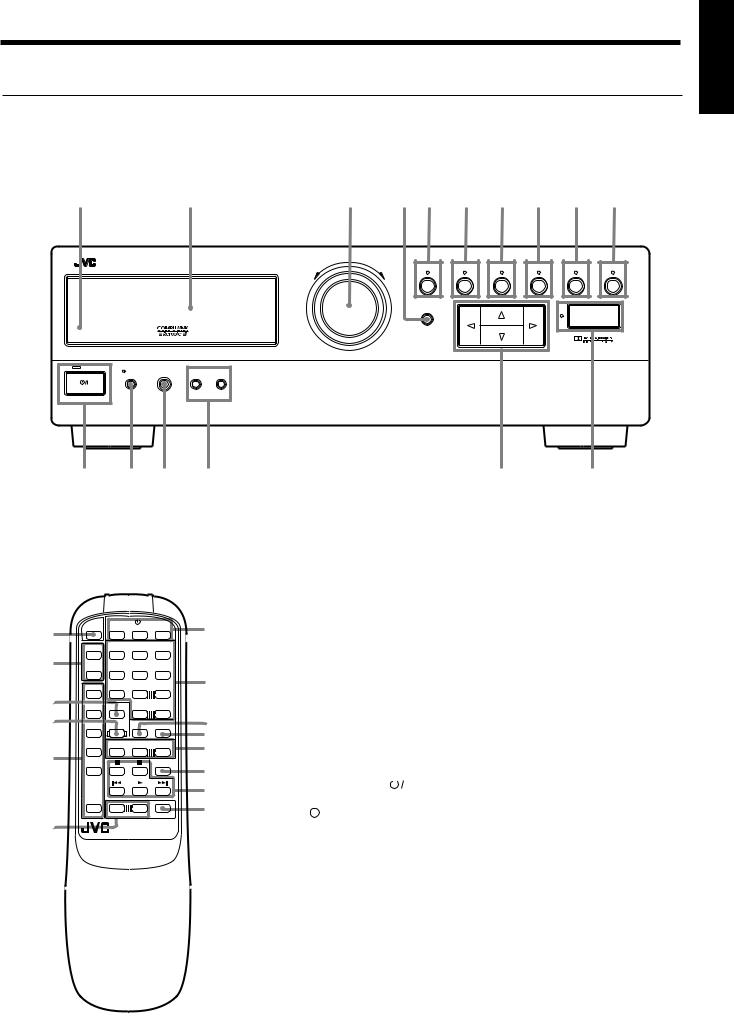
Switches, Buttons and Controls
Become familiar with the buttons and controls on the receiver before use.
English
1 |
2 |
3 |
4 |
5 |
6 |
7 |
8 |
9 |
p |
|
|
MASTER VOLUME |
|
|
|
|
|
|
|
RX-430V |
AUDIO/VIDEO CONTROL RECEIVER |
|
|
TUNER/BAND |
PRESET SEA |
SOURCE |
SURROUND |
ADJUST |
SETTING |
–+
|
|
|
|
MEMORY |
|
|
|
|
|
|
ONE TOUCH OPERATION |
STANDBY |
|
|
|
|
|
|
POWER |
PHONES |
SPEAKERS |
|
|
|
|
1 |
|
2 |
|
|
|
|
|
ENHANCED COMPULINK CONTROL SYSTEM |
|
|
_ON —OFF |
|
_ON —OFF |
|
|
STANDBY/ON |
|
|
|
|
|
q |
w |
e |
r |
t |
y |
u
i
o
;
a
s
TV |
|
|
/I |
|
|
/VIDEO |
TV |
|
VCR |
AUDIO |
|
CH+ |
1 |
|
PRESET |
SEA MODE |
|
|
2 |
|
3 |
||
CH– |
TEST |
|
DELAY SURR MODE |
||
4 |
|
5 |
|
6 |
|
|
|
|
– REAR |
+ |
|
CD |
7/P |
|
8 |
|
9 |
|
CD-DISC |
– CENTER |
+ |
||
TAPE |
10 |
+10 |
|||
FM/AM |
AUDIO |
|
SEA |
SURROUND |
|
CONTROL |
ON/OFF |
ON/OFF |
|||
VCR |
TV |
TV CONTROL |
|
||
|
– VOLUME + |
||||
VIDEO |
|
|
|
ONE TOUCH |
|
|
|
|
OPERATION |
||
PHONO
–VOLUME + MUTE
RM-SR430EU REMOTE CONTROL
Refer to the pages in parentheses for details.
|
Front Panel |
||||||
|
1 |
Remote sensor |
|||||
d |
2 |
Display (10) |
|||||
3 |
MASTER VOLUME control (11) |
||||||
|
|||||||
|
4 |
MEMORY button (16) |
|||||
|
5 |
TUNER/BAND button and lamp |
|||||
f |
|
(16, 17) |
|
|
|
||
|
6 |
PRESET SEA button and lamp (18) |
|||||
g |
7 |
SOURCE button and lamp (10) |
|||||
8 SURROUND button and lamp |
|||||||
h |
|
(20, 23, 26) |
|
|
|
||
j |
|
|
|
|
|||
9 |
ADJUST button and lamp (21, 23) |
||||||
|
|||||||
k |
p SETTING button and lamp (13) |
||||||
l |
q STANDBY/ON |
|
|
button and |
|||
|
|
||||||
|
|||||||
|
STANDBY lamp (10) |
||||||
/ |
|
||||||
w |
|
POWER switch (9) |
|||||
|
|||||||
|
|
||||||
e PHONES jack (12)
r SPEAKERS 1/2 buttons (11) t Control %/ fi/ @/ #buttons
y ONE TOUCH OPERATION button and lamp (15)
Remote Control
u TV/VIDEO button (29) i CH (+/–) buttons (29) o CD-DISC button (28)
; AUDIO CONTROL button (19, 21, 25, 26)
a Source buttons (CD, TAPE, FM/ AM, VCR, VIDEO, PHONO) (10, 28, 29)
s VOLUME (+/–) buttons (11) d 

 (Standby/On) buttons (TV,
(Standby/On) buttons (TV,
VCR, AUDIO) (10, 29)
f10 keys/Audio control buttons (17, 19, 21, 25, 26, 28)
g SEA ON/OFF button (19)
h SURROUND ON/OFF button (21, 25, 26)
jTV CONTROL buttons (TV, VOLUME (+/–)) (29)
kONE TOUCH OPERATION button (15)
lOperating buttons for JVC audio/ video components (28, 29)
/ MUTE button (11)
Page 2

English
Getting Started
This section explains how to connect stereo components and speakers to the receiver, and how to connect the power supply.
Before Installation
General
•Be sure your hands are dry.
•Turn the power off to all components.
•Read the manuals supplied with the components you are going to connect.
Locations
•Install the receiver in a location that is level and protected from moisture.
•The temperature around the receiver must be between –5˚ and 35˚ C (23˚ and 95˚ F).
•Make sure there is good ventilation around the receiver. Poor ventilation could cause overheating and damage the receiver.
Handling the receiver
•Do not insert any metal object into the receiver.
•Do not disassemble the receiver or remove screws, covers, or cabinet.
•Do not expose the receiver to rain or moisture.
Checking the Supplied Accessories
Check to be sure you have all of the following items, which are supplied with the receiver.
The number in the parentheses indicates quantity of the pieces supplied.
•Remote Control (1)
•Batteries (2)
•AM (MW/LW) Loop Antenna (1)
•FM Antenna (1)
If anything is missing, contact your dealer immediately.
Page 3
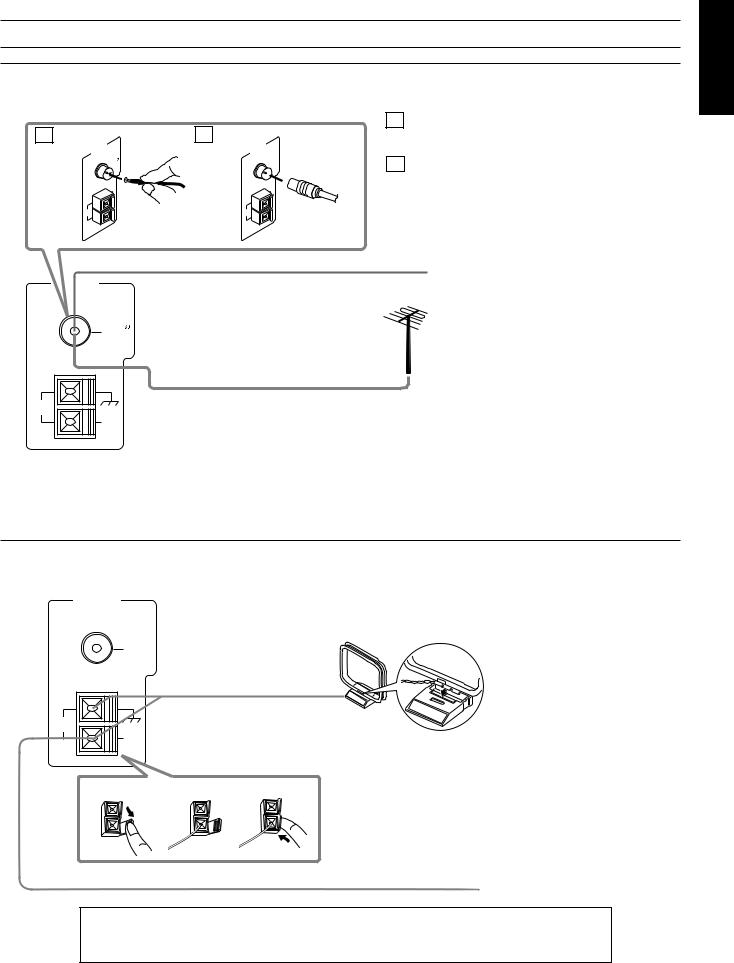
Connecting the FM and AM (MW/LW) Antennas
FM Antenna Connections
A |
B |
ANTENNA |
ANTENNA |
75 |
75 |
FM |
FM |
COAXIAL |
COAXIAL |
GND |
GND |
AM |
AM |
EXT |
EXT |
AM |
AM |
LOOP |
LOOP |
ANTENNA |
FM Antenna |
|
FM 75 |
|
COAXIAL |
|
GND |
AM |
Outdoor FM Antenna |
|
|
LOOP |
AM |
|
|
|
EXT |
English
AUsing the Supplied FM Antenna
The FM antenna provided can be connected to the FM 75ohm COAXIAL terminal as temporary measure.
BUsing the Standard Type Connector (Not Supplied)
A standard type connector (IEC or DIN45325) should be connected to the FM 75-ohm COAXIAL terminal.
Note: Make sure the antenna conductors do not touch any other terminals, connecting cords or power cord. This could cause poor reception.
Extend the supplied FM antenna horizontally.
If reception is poor, connect an outdoor FM antenna.
Before attaching a 75-ohm coaxial cable (the kind with a round wire going to the outdoor FM antenna), disconnect the supplied FM antenna.
AM (MW/LW) Antenna Connections
ANTENNA
FM 75
COAXIAL
AM (MW/LW) Loop Antenna
GND |
AM |
LOOP |
AM |
EXT |
Turn the loop until you have the best reception.
Snap the tabs on the loop into the slots of the base to assemble the AM (MW/LW) loop.
1 |
2 |
3 |
|
|
|
|
If reception is poor, connect an outdoor single vinyl- |
|
|
|
covered wire to the AM EXT terminal. (Keep the AM |
|
AM (MW/LW) Wire Antenna |
(MW/LW) loop antenna connected.) |
|
Note :
Make sure the antenna conductors do not touch any other terminals, connecting cords and power cord. This could cause poor reception.
Page 4
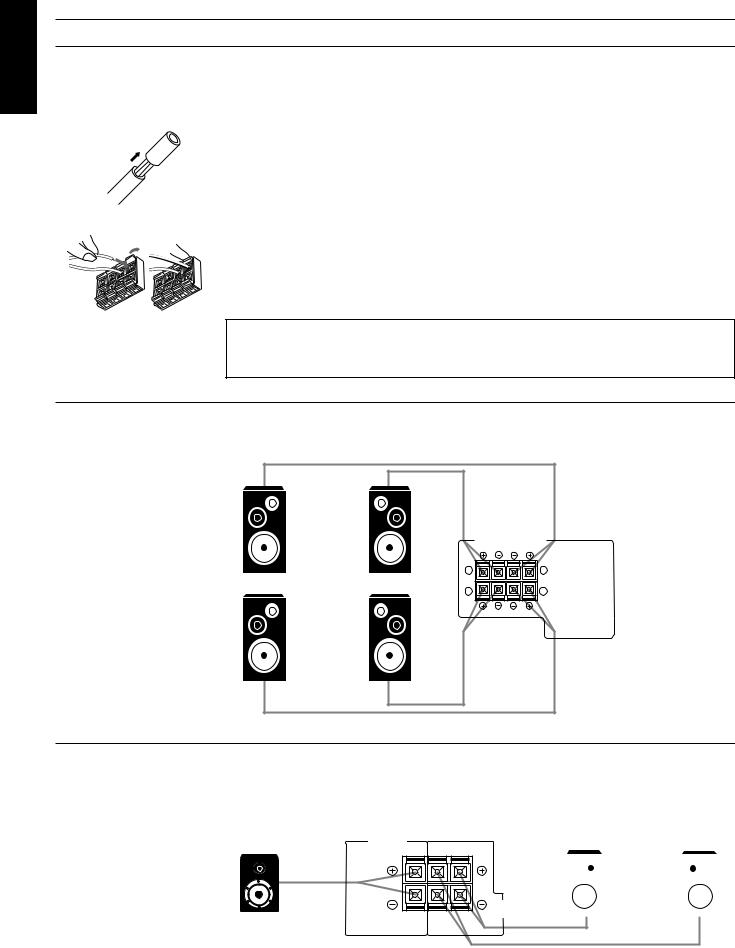
English
Connecting the Speakers
You can connect the following speakers:
•Two sets of front speakers to produce normal stereo sound
•One set of rear speakers to enjoy the surround effect
•One center speaker to produce more effective surround effect (to make human voices outstanding)
•One subwoofer to enhance the bass
For each speaker (except for subwoofer), connect one end of the speaker signal cable (not supplied) to the speaker terminal on the rear panel and the other end to the speaker. (For connecting a subwoofer, see page 7).
1.Open each terminal.
2.Insert the end of the speaker signal cable as shown (be sure to remove the insulation at the end
of each wire first).
3. Close the terminals to clamp the speaker signal cables firmly in place.
4. Connect the black (–) and red (+) terminals on the rear panel to the black (–) and red (+) terminals marked on the speakers.
CAUTION:
When connecting speakers, use speakers with the same SPEAKER IMPEDANCE indicated by the speaker terminals.
Connecting the front speakers
Connect the front speakers to the FRONT SPEAKERS terminals.
SPEAKERS 1
Left Speaker |
Right Speaker |
FRONT SPEAKERS
RIGHT |
LEFT |
1 |
1 |
2 |
2 |
SPEAKERS 2
Connecting the rear and center speakers
Connect rear speakers to the REAR SPEAKERS terminals and a center speaker to the CENTER SPEAKER terminals.
Center Speaker
CENTER |
|
SPEAKER |
LEFT |
RIGHT |
|
|
REAR |
|
SPEAKERS |
Left Rear |
Right Rear |
||||
Speaker |
Speaker |
||||
|
|
|
|
|
|
|
|
|
|
|
|
Note:
When you connect rear speakers, make sure that both left and right speakers are connected; otherwise, no sound will come out of the rear speakers.
Page 5
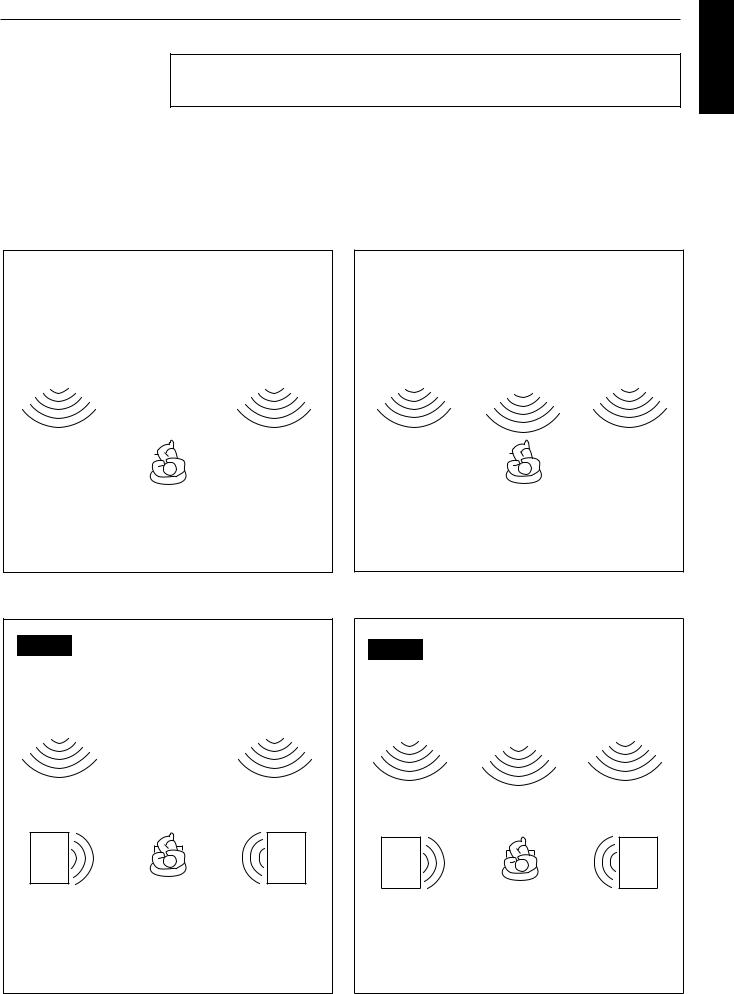
About the speaker impedance of the speakers
CAUTION:
When connecting speakers, use speakers with the same SPEAKER IMPEDANCE indicated by the speaker terminals.
Notes:
•The required speaker impedance of the front speakers does not differ depending on whether both the FRONT SPEAKERS 1 and FRONT SPEAKERS 2 terminals are used or only one of them is used.
•The required speaker impedance of the front speakers differs depending on whether or not a center and/ or rear speakers are connected at the same time. Since there are four possible speaker connections with the receiver, check which one fits your case and use the speaker with the impedance described below.
CASE 1 |
When you connect only front speakers |
CASE 2 |
When you connect front speakers and a center |
|
|
|
speaker |
Front |
|
|
|
|
|
|
Front |
|
Front |
|
|
|
|
|
|
|
Front |
Speaker |
|
|
|
|
|
|
Speaker |
|
Speaker |
|
|
|
|
|
|
|
Speaker |
|
|
|
|
|
|
|
|
|
|
Center Speaker |
|
||||||
|
|
|
|
|
|
|
|
|
|
|
|
|
|
|
|
|
|
|
|
|
|
|
|
|
|
|
|
|
|
|
|
|
|
|
|
Use front speakers with 4 — 16 ohm impedance. |
Use the following speakers; |
|
|
• Front speakers: 8 — 16 ohm |
impedance |
|
• Center speaker: 8 — 16 ohm |
impedance |
English
CASE 3 When you connect front and rear speakers
Front |
|
Front |
Speaker |
|
Speaker |
|
|
|
Rear |
Rear |
Speaker |
Speaker |
Use the following speakers; |
|
||
• |
Front speakers: |
8 — 16 ohm |
impedance |
• |
Rear speakers: |
8 — 16 ohm |
impedance |
CASE 4 When you connect front and rear speakers as well as a center speaker
Front |
|
|
|
Front |
Speaker |
|
|
|
Speaker |
|
Center Speaker |
|
||
|
|
|
|
|
Rear |
Rear |
Speaker |
Speaker |
Use the following speakers; |
|
||
• Front speakers: |
8 |
— 16 ohm |
impedance |
• Rear speakers: |
8 |
— 16 ohm |
impedance |
• Center speaker: 8 |
— 16 ohm |
impedance |
|
Page 6
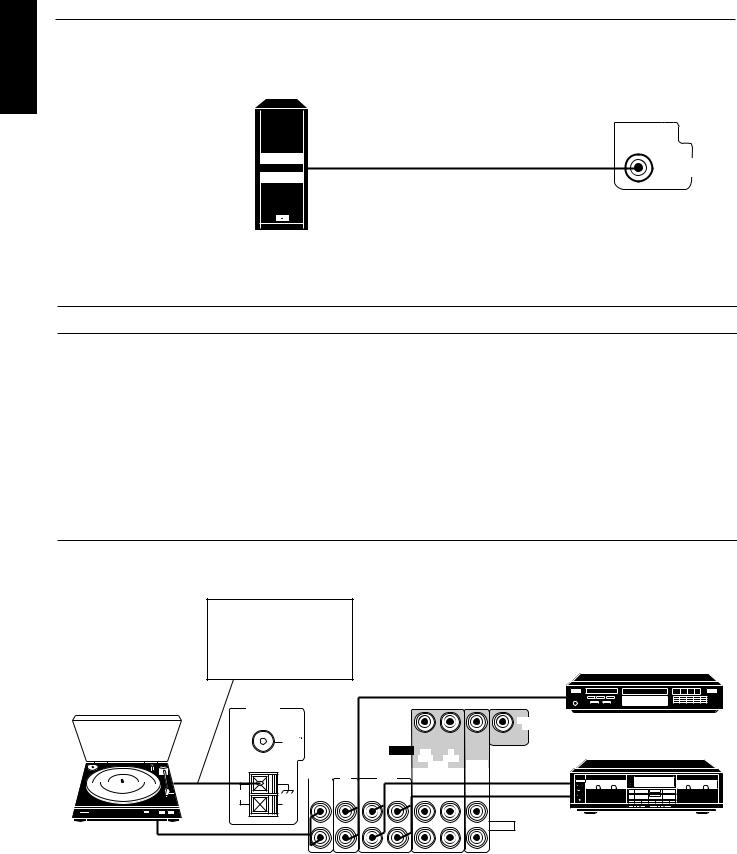
English
Connecting the subwoofer speaker
Connect the input jack of a powered subwoofer to the SUBWOOFER OUT jack on the rear panel, using a cable with RCA pin plugs.
SUBWOOFER
OUT
Powered subwoofer
Connecting Audio/Video Components
You can connect the following components to the receiver using cables with RCA pin plugs.
Audio Components |
Video Components |
||
|
|
|
|
• |
Turntable |
• |
VCR |
|
|
|
|
• |
CD player |
• |
Video disc player |
|
|
|
|
• |
Cassette deck |
• |
TV |
Note:
Any turntables incorporating a small-output cartridge such as an MC (moving-coil type) must be connected to the receiver through a commercial head amplifier or step-up transformer. Direct connection may result in insufficient volume.
Audio component connections
If a ground cable is provided for your turntable, connect the cable to the GND terminal of the AM LOOP terminals on the rear panel.
To audio output
ANTENNA
MONITOR
OUT
FM 75
COAXIAL
VIDEO OUT |
IN |
(REC) |
(PLAY) |
CD player
Turntable
Turntable
|
|
|
|
|
VCR |
VIDEO |
|
|
|
GND |
PHONO |
CD |
TAPE |
|
|
To audio input |
|
||
AM |
|
OUT |
|
IN |
OUT |
IN |
|
|
|
|
(REC) |
(PLAY) |
(REC) |
(PLAY) |
|
|
|
||
LOOP |
|
|
|
|
|||||
|
|
|
|
|
|
|
To audio |
|
|
AM |
|
|
|
|
|
|
|
|
|
EXT |
|
|
|
|
|
|
LEFT |
|
|
|
|
|
|
|
|
|
output |
|
|
|
|
|
|
|
|
|
AUDIO |
Cassette deck |
|
To audio output
RIGHT
Page 7
